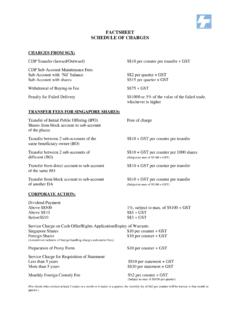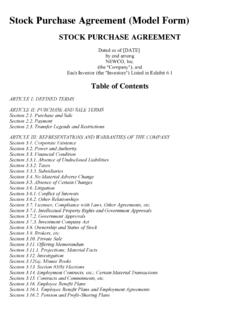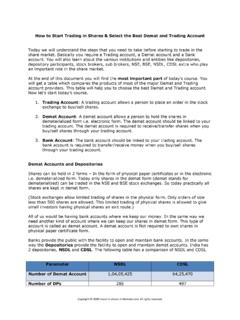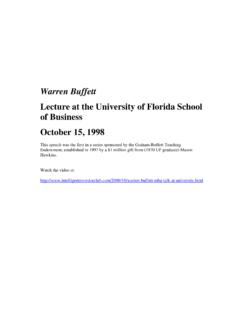Transcription of CIRCUIT BREAKERS FAQs - Lim & Tan
1 Page 2 CIRCUIT BREAKERS faqs GENERAL 1) What is a CIRCUIT breaker ? A CIRCUIT breaker is a price band set which varies with movements in the traded price of the instrument throughout the day. The price band comprises an upper and lower price limit based on a deviation of 10% from the reference price. (See question 11 of this FAQ for information on how the reference price is determined.) 2) What is the reason for introducing CIRCUIT BREAKERS on SGX? There are no CIRCUIT BREAKERS in place in the SGX Securities market currently. In the event of rapid price movements, investors may not have time to make informed decisions when they trade. CIRCUIT BREAKERS are intended to guard against disorderly situations in the face of rapid and unchecked market movements. By implementing CIRCUIT BREAKERS , investors are given time to assimilate incoming information and make informed choices during periods of high market volatility.
2 3) How does it work? The CIRCUIT breaker is activated when an incoming order could potentially match an existing order in the order book at a price outside the CIRCUIT breaker price band. Trades at the limits will not activate the CIRCUIT breaker . 4) What happens when the CIRCUIT breaker is activated? When the breaker is activated, a cooling off period of five minutes will take place. During the cooling off period, trading can still take place within the existing price band. All the existing orders will be unaffected and new orders can still be placed in the order book as long as they do not result in the matching of trades outside the price bands. Any incoming order that is immediately able to match against another order at a price outside of the existing price band will be rejected. However, it will not extend the cooling-off period. Page 3 An illustration Scenario: CIRCUIT breaker for ABC shares is triggered and a 5-minute cooling off period is in place.
3 1) There are only 5 lots of sell order of ABC shares in the order book when the cooling off period starts (Price 2) Investors A puts in a sell order of 5 lots of ABC shares at $ Though this order is outside the upper limit, it is accepted as there is no corresponding match of orders. 3) Investor B puts in a buy market order of 10 lots of ABC shares. Only buy orders on 5 lots of ABC shares will be accepted and matched against the existing sell order of ABC shares at $11. The other 5 lots of buy order for ABC shares will be rejected by the system as it can match the 5 lots of sell order of ABC shares at $ , which is outside the upper limit. 5) How do investors know when the CIRCUIT breaker is triggered? When the CIRCUIT breaker is activated, a CIRB indicator will appear in the Rmk column of the affected counter on the price page of the SGX website for the duration of the cooling-off period.
4 CIRB Page 4 6) How do brokers know the CIRCUIT breaker is activated? When the CIRCUIT breaker is activated, an announcement will be broadcasted to notify Trading Members of the activation of the CIRCUIT breaker . The announcement will take the form of a session state broadcast to Trading Members via their Trading APIs. Trading Member if required, will then be able to relay the necessary information to its client. 7) How do brokers know their orders are rejected due to the activation of or during cooling off period? When an order is rejected due to the activation of or during a cooling-off period, brokers get return codes from the trading engine, similar to other instances of order rejection. The return codes for this form of rejection are as follows: (a) Code 17 no part of the order placed in the order book and no part filled; or (b) Code 19 order partially filled and nothing placed in the order book.
5 8) Will the cooling off period be extended? No, during a cooling off period, if any incoming order can potentially match against an order outside the price band, it will be rejected. However, the cooling off period will not be extended. 9) When is the CIRCUIT breaker in operation? The breaker will operate continuously from 9:00 am to 17:00 pm on a normal trading day during the continuous trading phase. Accordingly, it will not be active during the opening and closing routine. Participants will be able to place orders outside the breaker limits during the opening and closing routines and the resulting prices could lie outside the breaker limits. The opening and closing routines inherently limit the risk of disorderly trading since all trades are executed at one price at the end of each routine. 10) Will there be instances when the cooling off period of the CIRCUIT BREAKERS will be shorter than 5 minutes ?
6 The cooling off period will cease operation upon the commencement of any for the following, even if five minutes has not elapsed: (a) Pre-Close Phase; (b) Suspension; and (c) Trading Halt. Page 5 11) How is reference price set? First Reference Price of the Day The first reference price of the day is determined as follows: (a) the opening price of that day; failing which (b) the last traded price (or closing price) on the previous trading day; failing which (c) the last available traded price. Reference Price During Continuous Trading The dynamic reference price during continuous trading is determined as follows: (a) the last traded price as of five minutes prior to each potential trade; or, (b) if no trades are executed in the continuous matching phase of that trading day, the first reference price of the trading day. Reference Price after Cooling-off Period If there are trades done during the cooling-off period, the reference price for trading after the cooling-off period will be (a) the last traded price as of five minutes prior to each potential trade (accurate to the nearest second, and from the last trade done in the second); or, (b) if no trades are executed in the continuous matching phase of that trading day, the first reference price of the trading day.
7 If no trades are done during the cooling-off period, the first trade after the cooling-off period will not be subject to any CIRCUIT breaker . It can be executed at a price outside the price band, and will serve as the reference price for the next five minutes . Reference price following the lifting of a halt/suspension In the event that trading has been suspended or halted for any reason, the CIRCUIT breaker will be in operation when trading resumes. The reference price for the first five minutes immediately following the resumption is determined as follows: (a) the Equilibrium Price; failing which (b) the last traded price in the Trading Phase preceding the halt/suspension; failing which (c) the first reference price of the trading day. 12) Will the reference price and price bands be disseminated? No, the reference price and price bands will not be disseminated to market participants in the initial launch.
8 13) What instruments are covered by CIRCUIT BREAKERS ? The instruments covered include: (a) all Straits Times Index and MSCI Singapore Index component stocks Page 6 (b) all other stocks/units with a price at or more than $ in the underlying currency including: a. Stapled securities b. Funds c. Exchange Traded Funds d. Exchange Traded Notes (c) all Extended Settlement Contracts whose underlying is subject to the CIRCUIT BREAKERS 14) What is the threshold for non-Singapore Dollar denominated instruments? A consistent threshold of $ has been adopted across all instruments in different currencies to avoid confusion to market participants. 15) What is the reference price for Extended Settlement contracts (ESC)? The reference price for an ESC will be the reference price of its underlying instrument at all times1. The price band for ESC will therefore be the same as its underlying.
9 16) What happens to Structured and Company Warrants when the underlying counter is in cooling-off period? When an instrument is in cooling-off period, the associated Structured and Company warrants will halt trading. The halt in trading will lift with the end of the cooling-off period of the underlying instrument. 17) How do investors know that trading in Structured and Company Warrants has halted when the underlying counter is in cooling-off period? When the Structured and Company Warrants are halted due to the activation of CIRCUIT breaker in the underlying instrument, a CIRH indicator will appear in the Rmk column of the affected counter on the price page of the SGX website for the duration of the cooling-off period. CIRH 18) Are CIRCUIT BREAKERS for dual currency counters linked? 1 For the STI ESC, the reference price will be the reference price of the SPDR STI ETF.
10 Page 7 Dual currency counters on the same underlying instrument will be subject to independent CIRCUIT BREAKERS . 19) Are CIRCUIT BREAKERS for counters with different board lot sizes on the same underlying linked? Related counters of different board lot sizes on the same underlying such as Singtel/10/100 will be subject to the CIRCUIT breaker independently, with no coordination of price bands or cooling-off periods. 20) Will CIRCUIT BREAKERS apply to IPOs? CIRCUIT BREAKERS will not apply for IPO instruments on the first day of trading. This is because the offer price of a New Listing may differ significantly from market prices. Imposing CIRCUIT BREAKERS on the first day may impede the price discovery process unnecessarily. 21) Will CIRCUIT BREAKERS apply to the unit share and buying-in markets? No, the unit share and buying-in markets will not be covered by CIRCUIT BREAKERS .











